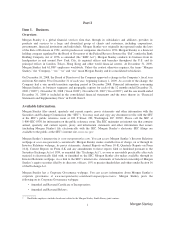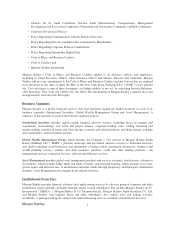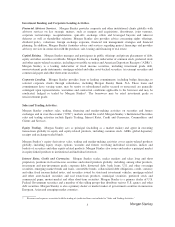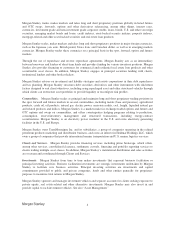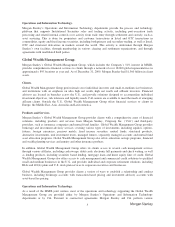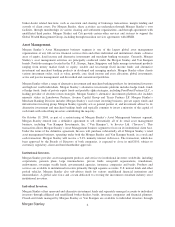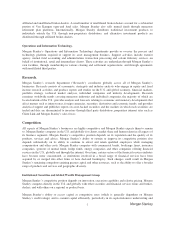Morgan Stanley 2009 Annual Report Download - page 15
Download and view the complete annual report
Please find page 15 of the 2009 Morgan Stanley annual report below. You can navigate through the pages in the report by either clicking on the pages listed below, or by using the keyword search tool below to find specific information within the annual report.
Current U.S. risk–based capital and leverage guidelines require Morgan Stanley’s capital–to–assets ratios to meet
certain minimum standards. Under the guidelines, banking organizations are required to maintain a total capital ratio
(total capital to risk–weighted assets) of at least 10% and a Tier 1 capital ratio of at least 6% in order to qualify as
well capitalized and for the holding company parent to be able to qualify as a financial holding company.
Morgan Stanley currently calculates its capital ratios and risk-weighted assets in accordance with the capital
adequacy standards for financial holding companies adopted by the Fed, which are based upon a framework
described in the “International Convergence of Capital Measurement and Capital Standards,” July 1988, as
amended, also referred to as “Basel I.” U.S. banking regulators are in the process of incorporating the Basel II
Accord into the existing risk–based capital requirements and Morgan Stanley is working with its regulators
accordingly to transition to these requirements.
The federal banking regulators also have established minimum leverage ratio guidelines. The Tier 1 leverage
ratio is defined as Tier 1 capital divided by adjusted average total book assets (which reflects adjustments for
disallowed goodwill, certain intangible assets and deferred tax assets). The adjusted average total assets are
derived using weekly balances for each quarter. The minimum leverage ratio is 3% for bank holding companies
that are considered “strong” under Fed guidelines or which have implemented the Fed’s risk–based capital
measure for market risk. Other bank holding companies must have a minimum leverage ratio of 4%.
Reform proposals affecting the scope, coverage, or calculation of capital, and increases in the amount of capital,
including more restrictive leverage ratios, capital conservation measures and liquidity coverage requirements
could adversely affect Morgan Stanley’s ability to generate return on capital, to pay dividends, or could require
Morgan Stanley to reduce business levels or to raise capital, including in ways that may adversely impact its
shareholders or creditors.
See also “Management’s Discussion and Analysis of Financial Condition and Results of Operation—Liquidity
and Capital Resources—Regulatory Requirements” herein.
Dividends.In addition to certain dividend restrictions that apply by law to certain of Morgan Stanley’s subsidiaries,
as described below, the OCC, the Fed and the FDIC have authority to prohibit or to limit the payment of dividends by
the banking organizations they supervise, including Morgan Stanley, Morgan Stanley Bank, N.A. and other Morgan
Stanley depository institution subsidiaries, if, in the banking regulator’s opinion, payment of a dividend would
constitute an unsafe or unsound practice in light of the financial condition of the banking organization. It is Fed
policy that bank holding companies should generally pay dividends on common stock only out of income available
from the past year, and only if prospective earnings retention is consistent with the organization’s expected future
needs and financial condition. It is also Fed policy that bank holding companies should not maintain dividend levels
that undermine the company’s ability to be a source of strength to its banking subsidiaries.
Prompt Corrective Action.The Federal Deposit Insurance Corporation Improvement Act of 1991 provides a
framework for regulation of depository institutions and their affiliates, including parent holding companies, by
their federal banking regulators. Among other things, it requires the relevant federal banking regulator to take
“prompt corrective action” with respect to a depository institution if that institution does not meet certain capital
adequacy standards. Current regulations generally apply only to insured banks and thrifts such as Morgan Stanley
Bank, N.A. or Morgan Stanley Trust, and not to their parent holding companies, such as Morgan Stanley. The
Fed is, however, subject to limitations, authorized to take appropriate action at the holding company level. All
pending proposals in the U.S. would broaden the Fed’s or appropriate regulator’s ability to take prompt
corrective action against a systemically important financial institution.
Transactions with Affiliates.Morgan Stanley’s domestic subsidiary banks are subject to Sections 23A and 23B
of the Federal Reserve Act, which impose restrictions on any extensions of credit to, purchase of assets from, and
certain other transactions with, any affiliates. These restrictions include limits on the total amount of credit
exposure that they may have to any one affiliate and to all affiliates, as well as collateral requirements, and they
require all such transactions to be made on market terms.
11


